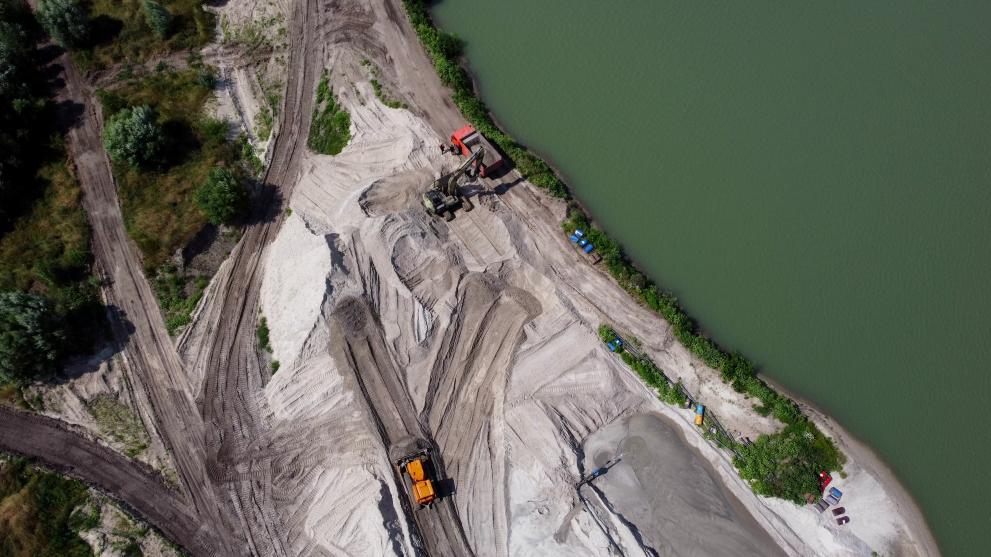
After water, sand (including gravel) is the second-most exploited natural resource in the world, earning it the nickname ‘the new gold’. Sand has been extracted from beaches, coastal dunes and watercourses at an accelerating pace in the past 20 years, with the two leading drivers being sand’s use as aggregate in concrete, and for beach reconstruction to protect coastal property. In 2019, demand for sand reached 50 billion tonnes per year1. Europe and Asia remain the larger markets.
Sand mining2 causes environmental, social and economic damage worldwide, with the researchers of this study presenting the different aspects of this damaging practice. Current rates of sand extraction exceed natural replenishment rates, leaving mined ecosystems very slow or even unable to recover. Sand mining changes how waterways flow and flood, threatens water security and lowers groundwater capacity, in turn raising water costs for local communities. It causes habitat loss and reduced biodiversity (especially for aquatic ecosystems), also contributing to climate change through the sand extraction process. The resulting erosion removes protection against coastal hazards, such as hurricanes, and extreme waves, and threatens critical infrastructure such as roads and railways. Sand extraction also damages coastal scenery which is necessary for tourism.
In the EU, mining for any mineral is subject to numerous environmental regulations3 and impact assessments, including directives concerning nature, industrial emissions, waste and water. Outside the EU, coastal and marine environments are protected via at least 15 regional conventions and other initiatives and legislation. However, outside the EU, illegal mining and trade can create an atmosphere of corruption in many coastal societies and leading to the creation of violent social groups (‘sand mafias’) that protect the ‘illegality’ of the activity, state the researchers. Given the difficulty of regulating sand mining, the researchers highlight the ‘dire’ need for global policy with real impact – policy to reduce sand mining and its adverse consequences for coastal areas, which are complex, severe, urgent, and ‘an out-of-hand problem’.
While sand may wrongly be considered a vast or limitless resource, its high-demand uses – concrete aggregate and beach nourishment – require sand of high quality with specific attributes, making it no different to other natural resources with a non-renewable, limited supply, argue the researchers. They call for a better management framework, exploration of coastal sand alternatives, an understanding of both the complex sand life cycle and coastal sand-supply network, and greater recognition of the concept of ‘sand rights’, via approaches that:
- reduce sand consumption;
- levy taxes and royalties on sand extraction;
- regulate the coastal sand mining process; and
- change construction methods and approaches to reduce the use of aggregate.
They discuss practices that could enable this, and suggest guidelines to steer global agenda-making on the regulation of sand extraction. For example, other mining waste could be dry-mined for sand; concrete could be recycled and used more efficiently; filler materials (e.g. construction waste or pulverised glass) could be used to regenerate beaches (though risks to human health, and impacts on the wider ecosystem and biodiversity would need to be considered); and new materials could be used in place of concrete (e.g. microplastics, timber). Even if it is unrealistic to eliminate concrete altogether, companies should move towards alternative materials in place of concrete, the researchers say; the construction industry should adopt a lifecycle approach, with the environmental impacts of materials considered and minimised from design through to end-of-life/disposal.
In terms of management, the study recommends empowering communities, including those in downstream environments who would be affected by sand extraction, as well as those who are reliant on sand resources (including local tourism industries). This would require addressing social contexts that include poverty, lack of education and knowledge of the impacts of sand extraction. The researchers indicate that sand flows through a complex cycle, just as wind and water do, and disrupting its flow inflicts damage ‘downstream’. Managing the use of sand requires integrated regional management between offshore regulators, coastal communities and the associated river basins that are the upstream sources of sand.
Footnotes:
- World Economic Forum: https://www.weforum.org/agenda/2022/06/global-sand-mining-demand-impacting-environment/ [Accessed 11/5/2023]
- Coastal Sand Mining refers to the extraction of sand and gravel sized between 0.05–2 mm size (sand) and 2–63 mm size (gravel) from coastal sites, including beaches, dunes, bluffs, cliffs, deltas as well as submerged coastal barriers, such as sand bars, tidal flats, tidal deltas and marine shelves.
- Mononen et al. (2022) Social and environmental impacts of mining activities in the EU. Available from: https://www.europarl.europa.eu/RegData/etudes/STUD/2022/729156/IPOL_STU(2022)729156_EN.pdf [Accessed 11/5/2023]
Source:
Rangel-Buitrago, N., Neal, W., Pilkey, O. and Longo, N. (2023) The global impact of sand mining on beaches and dunes. Ocean and Coastal Management 235 (2023) 106492.
To cite this article/service:
“Science for Environment Policy”: European Commission DG Environment News Alert Service, edited by the Science Communication Unit, The University of the West of England, Bristol.
Notes on content:
The contents and views included in Science for Environment Policy are based on independent, peer reviewed research and do not necessarily reflect the position of the European Commission. Please note that this article is a summary of only one study. Other studies may come to other conclusions.
Details
- Publication date
- 27 June 2023
- Author
- Directorate-General for Environment

